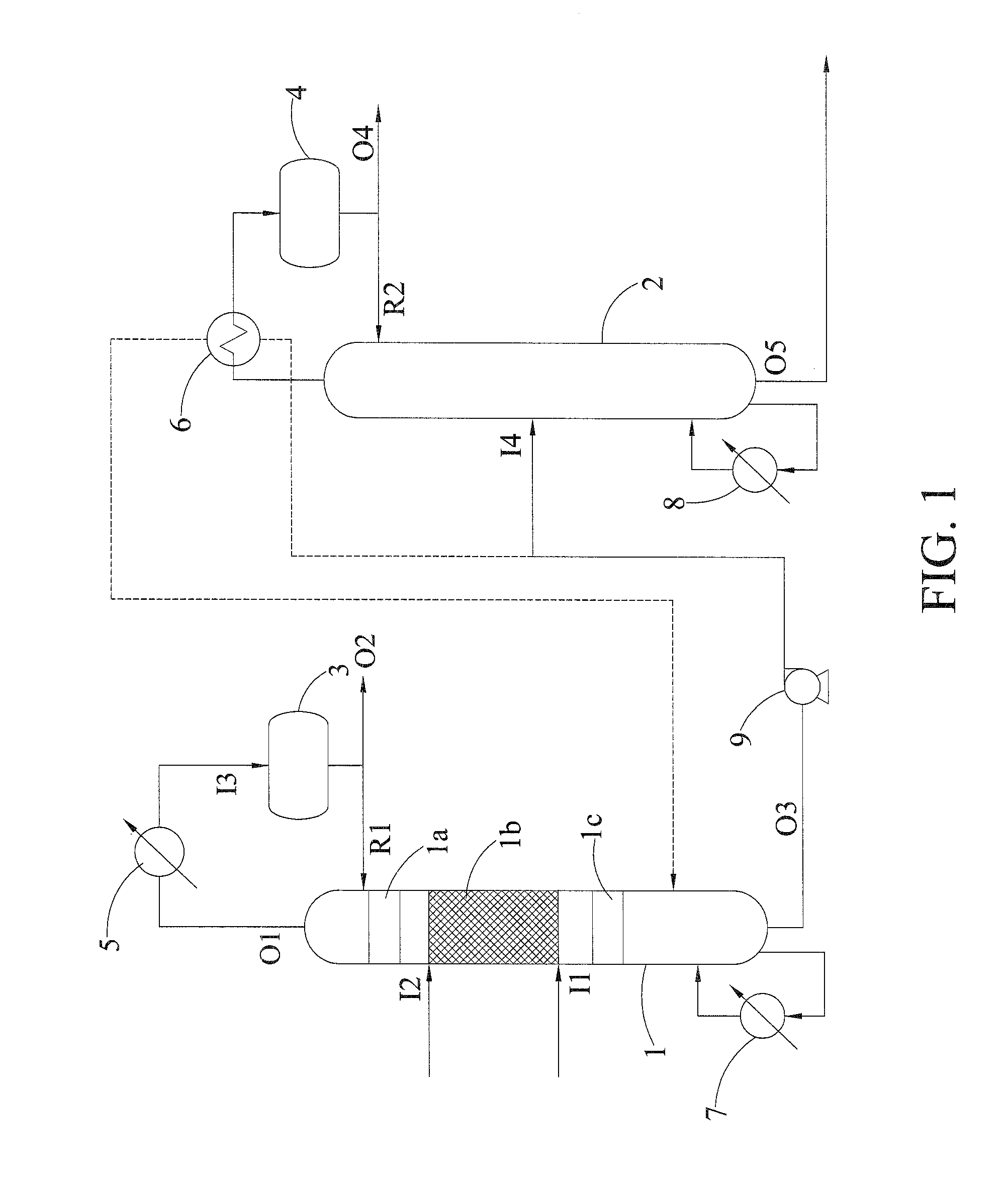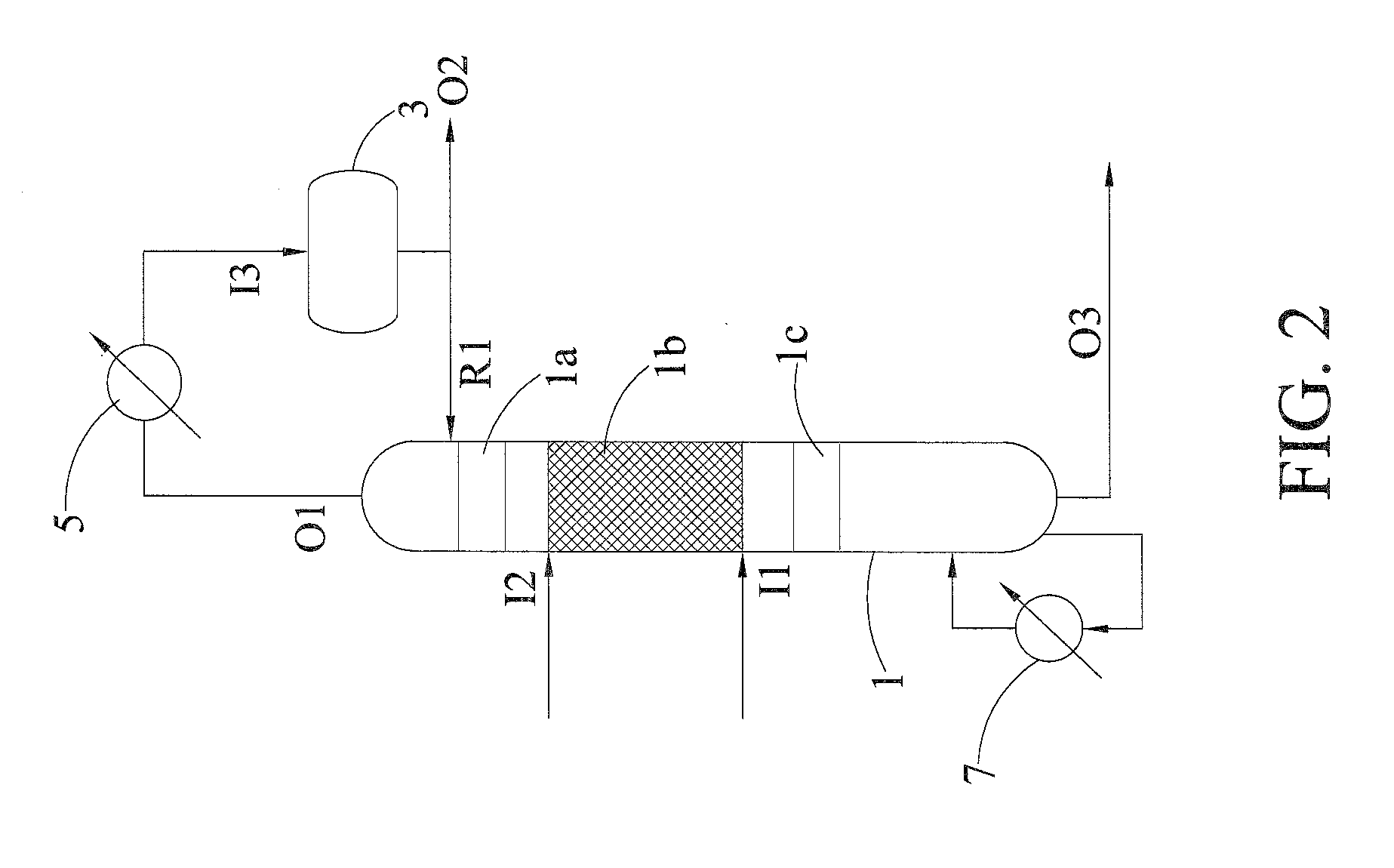Method for producing allyl alcohol
a technology of allyl alcohol and allyl acetate, which is applied in the direction of oxygen-containing compound preparation, sustainable manufacturing/processing, and separation processes, etc., can solve the problems of high energy consumption, complicated process proposed by u.s. patent no. 8,083,903 and other problems, to achieve the effect of reducing costs and preventing corrosion
- Summary
- Abstract
- Description
- Claims
- Application Information
AI Technical Summary
Benefits of technology
Problems solved by technology
Method used
Image
Examples
example 1
[0039]Allyl acetate solution with water was fed into the first inlet I1 and the allyl acetate and water were hydrolyzed in the reaction zone 1b, in which the catalyst box was packed with SK 104 resin catalyst (Mitsubishi Chemical), and then a mixture containing allyl alcohol, water and acetic acid was produced from the reaction zone 1b. The reboiler 7 was disposed at the bottom of the reactive distillation column 1 and the mixture at the bottom of the reactive distillation column was heated and vaporized. The outlet of the top of the reactive distillation column was connected with the condenser 5. After most of the gas mixture was condensed in the condenser 5 and introduced into the reflux drum 3 via the inlet 13 of reflux drum, most of liquid returned to the reactive distillation column 1 via the reflux inlet R1 and a small amount of liquid was discharged from the second outlet O2 or not discharged by using the total reflux operation.
[0040]In this example, the mixture containing al...
example 2
[0041]Example 2 was performed with the same system and condition as Example 1, except that the molar ratio of water to allyl acetate was about 1 in Example 2. Accordingly, allyl alcohol with 99.1% of purity was obtained from the outlet O4 and acetic acid with high purity was obtained from the outlet O5 at the bottom of the separating column.
example 3
[0042]In this example, excess water was used for enhancing the conversion rate of allyl acetate. Allyl acetate solution with water was fed into the first inlet I1. Since the boiling point of water was higher than the boiling point of the mixture containing water and allyl acetate, the excess water was fed into the second inlet 12, both of water and allyl acetate contact at a reverse flow in the reaction zone and then the hydrolysis was performed to produce the mixture containing allyl alcohol, water and acetic acid. The mixture containing allyl alcohol was obtained from the second outlet O2. The mixture containing acetic acid was obtained from the outlet at the bottom of the reactive distillation column.
[0043]Results of the examples are shown in Table 2.
TABLE 2Example 1Example 2Example 3AllylCompositionWater: 42.9%Water 15.4%Water: 42.9%acetate(wt %)Allyl acetate: 33.0%Allyl acetate 84.6%Allyl acetate: 33.0%feedingAcetic acid: 23.8%Acetic acid: 23.8%Azeotrope: 0.3%Heavy azeotrope:0....
PUM
| Property | Measurement | Unit |
|---|---|---|
| Temperature | aaaaa | aaaaa |
| Temperature | aaaaa | aaaaa |
| Pressure | aaaaa | aaaaa |
Abstract
Description
Claims
Application Information
 Login to View More
Login to View More - R&D
- Intellectual Property
- Life Sciences
- Materials
- Tech Scout
- Unparalleled Data Quality
- Higher Quality Content
- 60% Fewer Hallucinations
Browse by: Latest US Patents, China's latest patents, Technical Efficacy Thesaurus, Application Domain, Technology Topic, Popular Technical Reports.
© 2025 PatSnap. All rights reserved.Legal|Privacy policy|Modern Slavery Act Transparency Statement|Sitemap|About US| Contact US: help@patsnap.com


